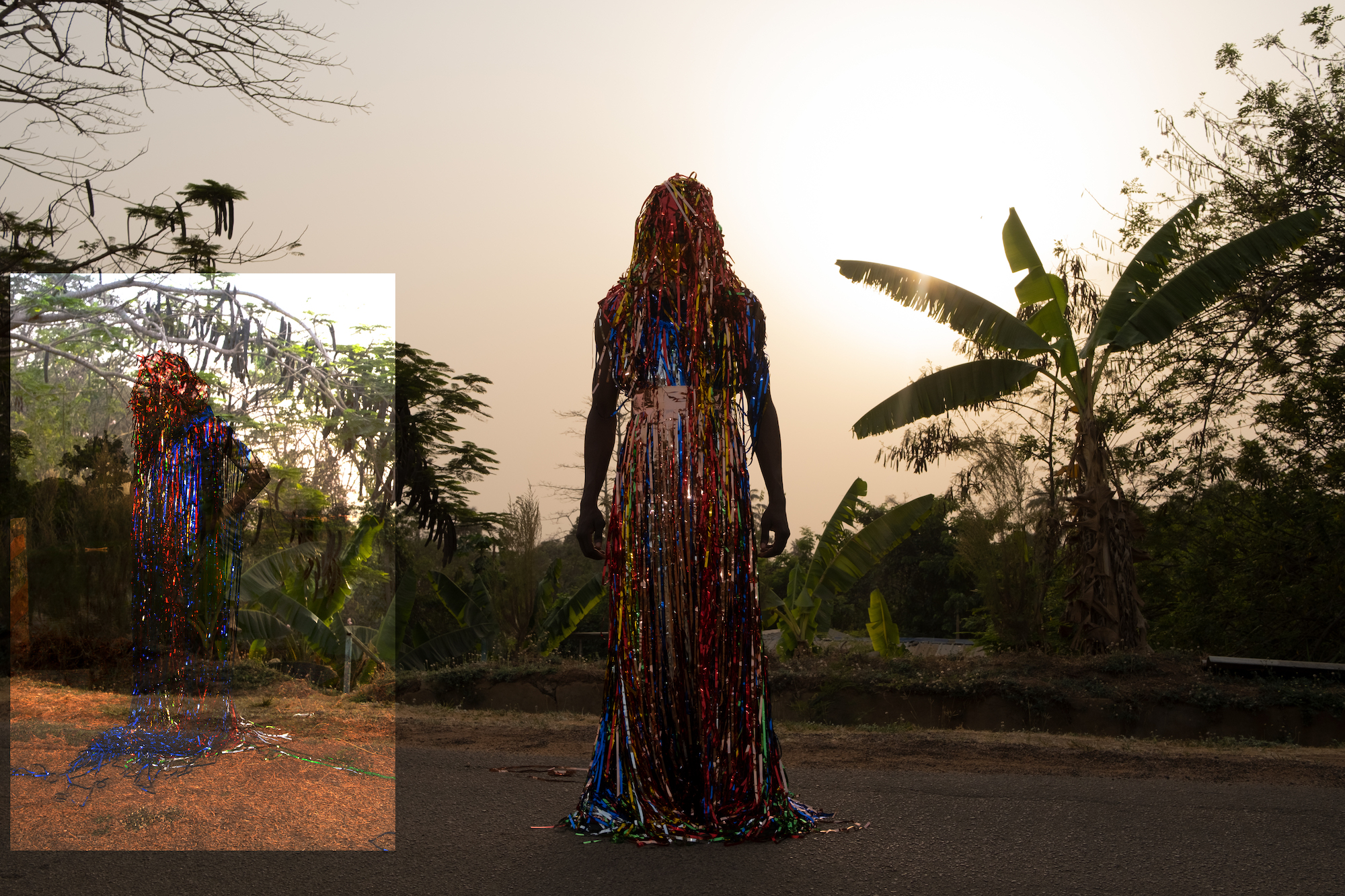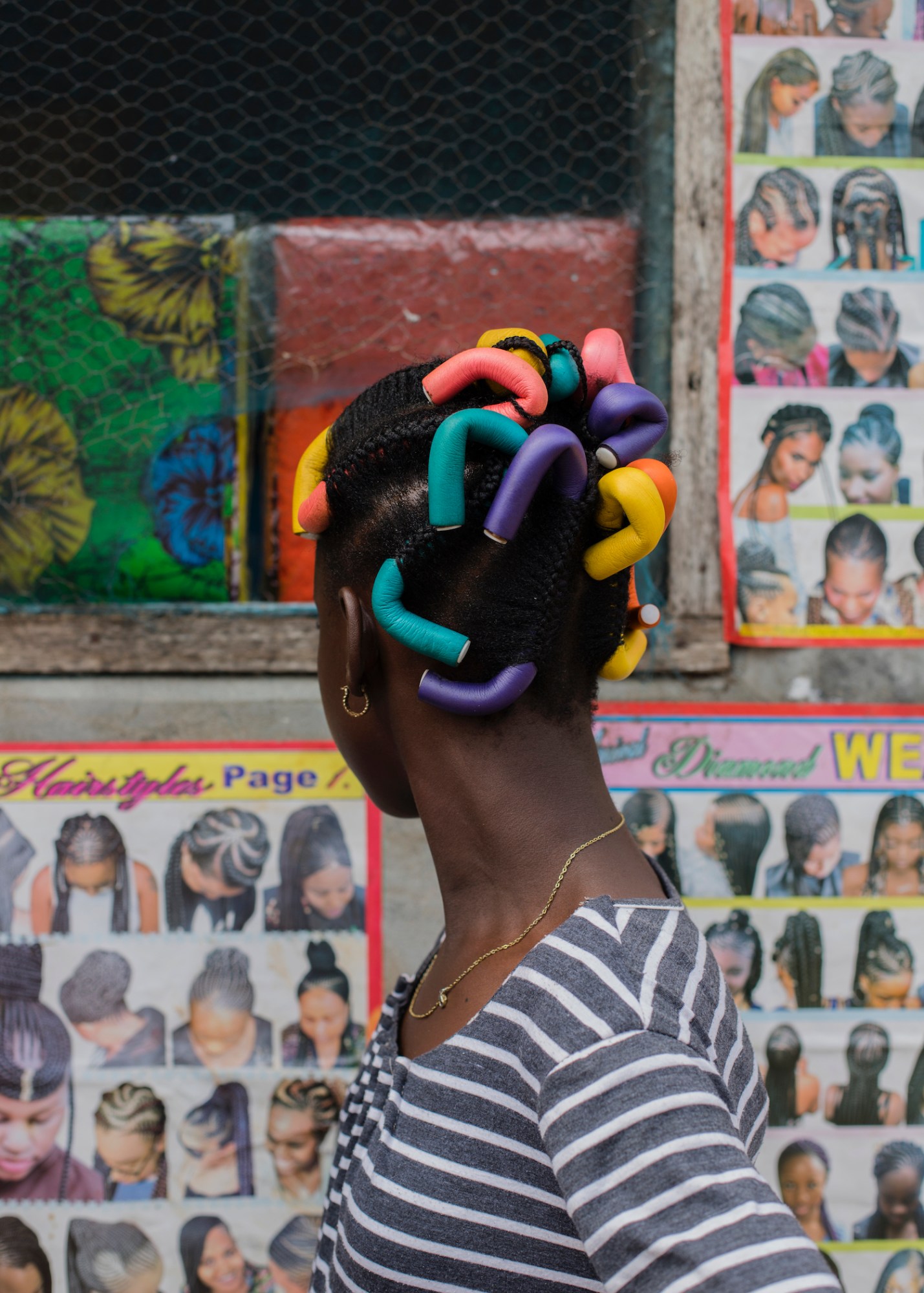Nigerian self-taught photographer Stephen Tayo has gained increasing attention for his celebration of African style. Scouting directly on the streets of Lagos, and contributing numerous times to the likes of i-D, Vogue and The New York Times, he conveys the vibrancy of his beloved city and country. His earlier series, Ibeji (meaning ‘twins’), explored the uncanny volume of doubling prevalent in Yoruba culture. His latest series, displayed in the group show Human Stories: The Satirists, is on view at NOW Gallery through November 13th (and, on another side London, his series What If? is exhibited at the V&A’s Africa Fashion exhibition).
Human Stories explores — alongside work by Bubi Canal, Nyugen Smith, Thandiwe Muriu, Leonard Suryajaya, and Thy Tran — the way satire can create a twist on or undercut presumptions about identity. Stephen’s series, Which Lagos You Dey?, specifically addresses fashion excess on a slant: the reality of mercantile hustle and buyer consumption depicted in an exaggerated way through surfeit materiality. While his work often highlights his relationship to his community, here, the anonymous model reflects the mutability of market life, that active socio-economic fulcrum swarmed by everybody and nobody.
Speaking on a video call from Marrakech — “it’s usually my ideal place to just take a break before I continue working on stuff” — Stephen discussed the incomparable animation of Lagos street life, diversifying his media choices, and the inspiring possibilities of materials (even those as elementary as bath sponges).

Can you tell me about this work, Which Lagos You Dey?
It’s a new series in which I carefully pick objects in Lagos that I find really interesting. The title is in broken English, which in essence means: “Which part of Lagos do you belong to.” It sort of extends and intensifies this idea, using familiar objects as symbolism.
Which objects were inspiring?
The constant, throughout this new work, is plastic, which is very important in Lagos. I was inspired by the way things are displayed in the street markets, where people buy things every day. I wanted things to stand out. These different objects feel representative: the colorful ribbon, for example, carries meanings through celebration, like you see it at a lot at birthday parties, at wedding parties. I wanted to speak to how every day is a celebration in Lagos, and to use that material to build a conversation. Another image features bath sponges. I played with caution tape, scarves, this Gucci paper bag very much available in the market… The series is ongoing, so I can find more fun stuff to play with.
You’re known as a portraitist, but the model here is perpetually faceless… The material seems to be overtaking or consuming the face and the body. Can you talk about that choice?
The intention is a case study; I’ve made this work for up to 11 months now. Lagos cannot really be boxed in, as an experience.
In terms of this idea you mentioned of “which” Lagos you participate in: how do you conceive of the city’s multiplicity, or different city-within-a-city types?
Lagos is different for different people, so l wanted to show that idea and not confine a place into one thing. It’s an existential question — it’s like showing a sort of diversity that exists within the city.

Are you exploring something here that you haven’t explored before through previous work?
Yes — and I haven’t done soundscape and motion before, so I wanted to use different mediums to show what goes on emotionally and socially. It’s beyond just images or collages: I wanted a strong in-person experience.
For the video piece, the motion reflects this constant, bubbly, ever-moving Lagos. With the sound, people in the market are speaking to each other and selling and chanting to advertise [their wares], and I’m using that sound to portray the idea of how fast, how unique, the exchange is here. I want people to understand the idea of buying and selling, the idea of street, the idea of place.
The name of this group show in which your series is displayed is called The Satirists. What are you satirizing, exactly? There’s clearly this sense of exaggeration, in the way the materials overtake the body, but can you expand further?
There’s satire in the sense of the idea of broken English, which could be comical, in a way. It’s an entry point to make the work more universal. Beyond the colors, beyond the aesthetics, there’s also an interest in using fashion as a focal point, of actively using that to ask questions about community, about place, about happenings. That stays a constant for me: wanting to observe and use fashion as a means of communication.
Over time, as a practicing photographer, is there an almost sociological or anthropological aspect to this idea of observation? Is this part of the photographic practice a way to chronicle social shifting?
I mean, every day you wake up to different news and in a different sort of headspace, and I think dealing with change and being aware of these changes is one of the key parts of being an artist. I think the curiosity comes with being aware, it’s what I really enjoy. I also like using my background in philosophy to sort of force stuff forward, like the idea of critical thinking, ensuring that there’s some sort of connection between my background and my current practice.
Are there other projects that you’re working on in tandem right now?
Yes, I’m working simultaneously, which I normally do. I’m looking into making like a book, hopefully before 2025. But at the moment, I’m just reading and researching… and sometimes taking a break to do commercial work, to do commissioned work. All of that is in between.
‘Human Stories: The Satirists’ is on view at NOW Gallery and What If? is on view at the V&A’s ‘Africa Fashion’ exhibition, both in London

Credits
All images courtesy Stephen Tayo



